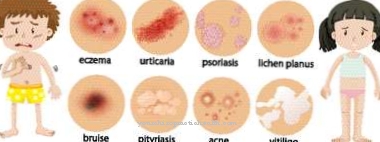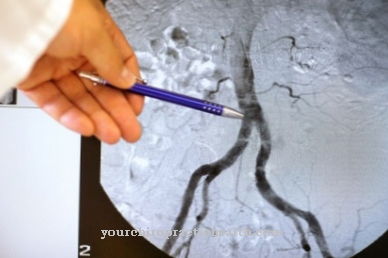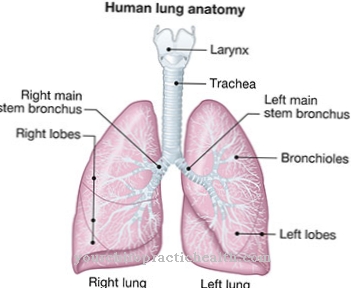Of the Warthin tumor is a benign tumor of the salivary gland. Older men in particular are affected by the neoplasm.
What is a Warthin tumor
For the first time the Warthin tumor already mentioned in 1895 by the German surgeon Otto Hildebrand. At that time the tumor was still called adenolymphoma. In 1910 the tumor was described in more detail by Heinrich Albrecht and Leopold Arzt and then made known by Warthin in 1929 as papillary cystadenoma lymphomatosum.
The Warthin tumor is also called Adenolymphoma or Cystadenolymphoma papilliferum designated. The mean age of onset is 62 years. The tumor is primarily found in men between the ages of 60 and 70. A manifestation in childhood is quite possible, but the tumor extremely rarely develops before the age of 40.
More and more men are affected by the tumor, but the incidence rate has shifted in recent years. While ten times more men than women were affected in the 1950s, today more and more women are falling ill due to changes in lifestyle. It is expected that in the future a balanced sex ratio will be achieved in terms of disease frequency.
causes
The cause of the tumor development is so far unknown. Although the disease is usually assigned to real neoplasms, the tumors could also be acquired multicystic reactive diseases. It was shown that the tumors are of polyclonal origin. However, other studies have shown that some of the Warthin tumors contain fusion genes between chromosome 11 and chromosome 19.
Exactly the same changes were found in the so-called mucoepidermoid carcinoma, a malignant neoplasm. Researchers suspect that the tumor originates from heterotropic salivary ducts in lymph nodes. Heterotropic tissue is outside of its actual anatomical location. This theory is supported by the fact that the Warthin tumors are often localized at the lower pole of the parotid gland.
Most of the lymph nodes are also found here. Still other hypotheses see the tumor as an adenomatous proliferation of tissue. This proliferation is said to cause lymphocytic infiltration. Smoking is a major risk factor. Smoking increases the incidence of the disease probably eight to ten times. The longer the person smokes, the greater the risk. The intensity of tobacco consumption, on the other hand, appears to play only a subordinate role.
Studies show that more than 90 percent of patients with Warthin's tumor are smokers. In addition, the risk of a bilateral tumor is increased in smokers. The mitochondrial DNA is believed to be damaged by smoking. In the histological examination, the cells of the Warthin tumor often show a missing mitochondrial DNA and pathologically changed mitochondria.
An increased incidence of illnesses was also observed after contact with ionizing radiation. For example, the Warthin tumors occurred more frequently in survivors of atom bomb explosions. The involvement of viruses in the development of tumors is also under discussion. The human herpes virus type 8 is often found in the cells of the tumor. In addition, the tumor occurs more frequently in HIV-infected patients. Various autoimmune diseases also appear to be associated with parotid gland tumors.
Symptoms, ailments & signs
A characteristic symptom of Warthin's tumor is a painless swelling in the area of the parotid gland. At the time of diagnosis, the tumor is usually between two and four centimeters in size. In extreme cases, however, it can also be twelve or thirteen centimeters tall.
Only a tenth of patients complain of pain. However, if the tumor tissue becomes inflamed, severe pain can occur. Compression of the facial nerve is also associated with pain. Facial paralysis, however, is only observed in rare cases.
Diagnosis & course of disease
Swelling in the area of the parotid glands suggests a Warthin's tumor. If there is any suspicion, imaging methods are used to confirm the diagnosis. Ultrasound, computed tomography or magnetic resonance tomography are suitable for diagnosis. Scintigraphy is only rarely used for diagnosis. In most cases, a definitive diagnosis can only be made on the basis of a preoperative biopsy.
The histological examination reveals a tumor that is demarcated by a thin connective tissue capsule. The tumor consists of epithelial areas and cysts that are embedded in lymphoid connective tissue. Cells and cell nuclei are usually normal. With the help of fine needle biopsy, correct diagnoses can be made in more than 95 percent of cases.
With the help of the removed tumor at the latest, the diagnosis can be confirmed thanks to a histological examination. Since the histological structure of the Warthin tumor is very characteristic, the diagnosis is usually unproblematic.Nevertheless, a differential diagnostic distinction must be made between lymphoepithelioma-like carcinoma and mucoepidermoid carcinoma.
Complications
In most cases, the Warthin tumor does not have any particular complications or a serious course. Since the tumor itself is benign, no direct treatment is usually necessary if the disease does not lead to severe restrictions in the patient's everyday life. Those affected suffer from swelling in the area of the ear.
The size of this swelling is very much dependent on the extent of the tumor, so that it can also have a negative effect on everyday life. In some cases, Warthin's tumor can cause severe pain, making patients dependent on treatment. If the tumor damages and compresses the nerve, it can lead to paralysis of the face. If the nerve is completely damaged, this paralysis can often no longer be remedied.
The treatment of the Warthin tumor takes place with the help of an operative intervention. There are no complications and the tumor can usually be completely removed, resulting in a positive course of the disease. Early diagnosis and treatment of this tumor does not negatively affect the patient's life counseling either.
When should you go to the doctor?
Since the Warthin tumor cannot heal itself as a rule, the person affected is dependent on a visit to a doctor. This is the only way to prevent further complications and complaints, so that a doctor should be contacted as soon as the first symptoms and signs of the disease appear. Men in particular should consult a doctor if the symptoms of Warthin's tumor occur. In most cases, this tumor is noticeable as a severe swelling that occurs around the ear.
This can usually be felt with the fingers. Also, severe pain in the ears often indicates a Warthin tumor if it occurs for no particular reason and does not go away on its own. This tumor can also lead to swelling or paralysis all over the face. A doctor should also be consulted with these complaints.
The disease can be diagnosed by a general practitioner or an ENT doctor. Further treatment usually takes place in a hospital. It cannot be universally predicted whether the disease will lead to a reduced life expectancy for the person affected.
Therapy & Treatment
As a rule, the Warthin tumor is completely removed surgically. The operation usually takes the form of a superficial parotidectomy. In this case, the outer lobe of the parotid gland is completely removed or peeled off. Peeling (enucleation) is preferable because the operation time is significantly shorter. In addition, the complication rate is lower and the cosmetic result is better.
Surgery is usually not required for patients at high risk of anesthesia. The Warthin tumor does not grow aggressively and does not metastasize, so removal is not absolutely necessary. It should be noted, however, that a malignant disease can be easily overlooked when a diagnosis is based solely on a fine needle biopsy.
prevention
Smoking appears to be the main risk factor for Warthin's tumor. Cigarettes and other tobacco products should therefore be avoided for prevention.
Aftercare
If the Warthin tumor has been completely surgically removed as part of a parotidectomy, follow-up treatment follows. In contrast to malignant tumors, which require regular follow-up care, the period immediately after the operation is sufficient for benign Warthin tumors.
The focus of the aftercare of the Warthin tumor is the control of wound healing. If the facial nerve has not been affected and there are no complications, no further follow-up measures are required. It normally takes around four weeks for the pain that occurs after the parotidectomy to subside.
After the operation, the patient is allowed to move. For about three days he wears a wound drainage to drain the wound fluid. It takes about six weeks to three months for the facial nerve to recover from the procedure. The surgical scar will gradually heal again. Sometimes a prolonged feeling of numbness on the earlobe can occur, which is usually unavoidable. The scar is often reddened for six months after the surgical procedure.
In certain cases, the patient is given antibiotic medication for a few days after the operation. In addition, an injection is made into the abdomen every day to prevent blood clots (thrombosis). If there is damage to the facial nerve, physiotherapy exercises are recommended to train the facial movements.
You can do that yourself
A Warthin tumor usually has to be removed surgically. In most cases, a superficial parotidectomy is necessary, in which the tumor is completely removed. The self-help of the patients is limited to the typical general measures such as rest and protection.
Before doing this, it is important to prepare adequately for the hospital stay. After the tumor has been removed, it is necessary to consult the doctor regularly. If you have unusual symptoms, a doctor is recommended. The doctor will make precise guidelines regarding physical restraint and other measures. Natural remedies help against the pain. The use of homeopathic preparations must be discussed with the doctor beforehand.
A tumor disease always represents a mental burden. The patient should contact a self-help group or a therapist at an early stage in order to work through the disease and to exchange experiences. The Internet is ideal for obtaining information. The German Cancer Society offers patients and relatives important points of contact and information. The competent ENT doctor can also support the treatment and aftercare and help the patient to quickly return to normal everyday life after the illness.





.jpg)


















.jpg)



